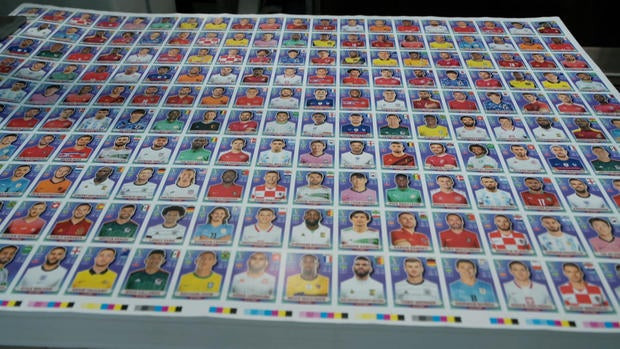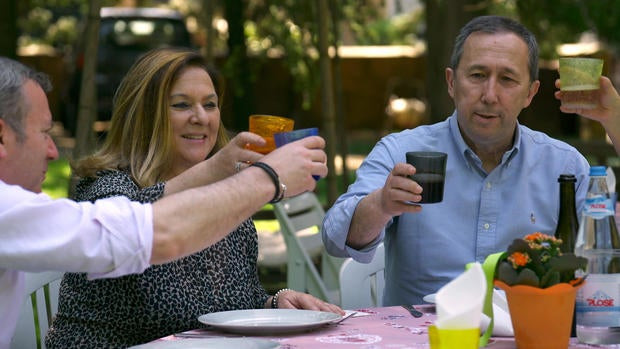Before the roar of the crowds and the thrill of victory at the World Cup, there’s a quieter, yet equally passionate sound: “got, got, need.” This isn’t the murmur of ticket scalpers, but the excited whispers of fans immersed in packs of World Cup stickers – soccer’s beloved answer to trading cards. The phenomenon began in Italy, ahead of the 1970 World Cup, when the Panini Family, four entrepreneurial brothers, started printing collectible stickers featuring players from every competing nation. Over half a century later, this tradition continues, with fans worldwide eagerly searching for that elusive sticker to complete their albums, making the Panini family name synonymous with soccer fandom. As we first explored, the Panini sticker craze has become a booming global industry and an integral part of the World Cup experience.
For countless soccer enthusiasts, the anticipation of the World Cup truly ignites weeks before the first whistle blows, with the highly anticipated release of Panini stickers for the quadrennial tournament.
From classrooms in Sudbury, England, to the bustling streets of Sao Paulo and Mexico City, fans from all walks of life embark on a shared quest: collecting 670 unique stickers showcasing the players and teams of each World Cup.
The ultimate goal? To proudly complete their Panini album.
Francesco Furnari, the largest official Panini distributor in the United States, perfectly captures the fervor: “Listen. If you have gold or a Panini sticker today, people will go for the sticker and not the gold.”
Jon Wertheim: “A Panini sticker’s more valuable than gold, you’re saying?”
Francesco Furnari: “Today, yes.”
This Italian-Venezuelan-American is a true believer in the Panini sticker magic.
Francesco FurnariHe has diligently completed every sticker album since 1974, including multiple editions of the 2022 collection.
Francesco Furnari: “I have already seven.”
Jon Wertheim: “You’re— you’re a man in your 50s. You have seven albums completed?”
Francesco Furnari: “And still counting.”
At $1.20 a pack, Furnari anticipates sticker sales in the U.S. alone for the 2022 World Cup to reach 100 million packets, and nearly a billion worldwide.
Jon Wertheim: “We’re talking about a little piece of paper with some adhesive on it. What makes this so special?”
Francesco Furnari: “Jon, you gotta understand that you have all your legends. You have all your best players at a distance of, you know, your hand. You can touch them, you can talk to them It’s fantastic.”
The allure of these stickers is undeniable. When Argentina faced a sticker shortage in September, it was deemed a national crisis, prompting the secretary of commerce to convene an emergency meeting to resolve the issue.
Jon Wertheim: “We live in a digital world. How are these paper stickers still this popular?”
Francesco Furnari: “This sensation, Jon, to get a pack, to rip it out, to smell it, to open it, and to find the players right here, there is no way you can replicate it in an electronic way.”
Jon Wertheim: “So you even have a method for how you’re ripping that packet open—”
Francesco Furnari: “Every single pack has to be done (LAUGH) in the same way. By the way, I’ve opened at least—”
Jon Wertheim: “You’ve done this before.”
Francesco Furnari: “–probably 2,000 packs up until now. Oh my God. Germany”
Jon Wertheim: “This was a good one? Good pack…”
Francesco Furnari: “That was a good pull. I love it.”
 Francesco Furnari opening Panini sticker packs
Francesco Furnari opening Panini sticker packs
To understand the heart of this global phenomenon, we journeyed to Modena, Italy, the home of Panini headquarters – a place akin to Willy Wonka’s factory for sticker enthusiasts.
Here, Panini stickers are produced around the clock, 21 hours a day, churning out an astonishing 11 million packets daily, each containing five stickers. Among them are the coveted headliners: Mbappe, Messi, Modric, and the rising stars of the soccer world. But the story of this empire began much more humbly, with the Panini family and a simple newspaper kiosk.
The origin of the Panini family sticker empire can be traced back to post-World War II Modena, next to the town’s cathedral. Olga Panini, a widowed newsstand owner, managed her business with her four sons. Each son possessed a unique talent, much like a well-rounded soccer team. Giuseppe, the eldest, was the visionary, the dreamer with grand ambitions.
In Modena, we met Antonio, Giuseppe’s son, and Laura and Lucia Panini, Giuseppe’s nieces, to delve into the family’s history.
Laura Panini described her uncle Giuseppe as “like a volcano. He had many, many ideas.”
Jon Wertheim: “A volcano?”
Laura Panini: “A volcano, yes.”
Giuseppe’s initial entrepreneurial spark was to sell cards featuring flowers.
Antonio Panini recounts, “And was a disaster (laugh). But they realized that the formula was okay, not the subject.”
 Laura and Antonio Panini sharing the family history
Laura and Antonio Panini sharing the family history
Running low on funds, Giuseppe took a final shot. In 1961, he turned his attention to a subject closer to the hearts of Italians: soccer. The Italian soccer stickers became an instant success, especially among children.
Early production methods were quite basic.
Lucia Panini explains, “All the stickers were printed and then were cut. And they were mixing with a shovel at the beginning.”
Jon Wertheim: “To make sure there were no duplicates (laugh) they mixed with a shovel.”
Lucia Panini: “Then they replaced a shovel with a churn, the one they use normally for making butter or cheese.”
Jon Wertheim: “With a butter churn?”
Lucia Panini: “Yes, yes. (laugh) And they had a handle, and they were moving this handle and it was working.”
Lucia PaniniGiuseppe’s brother Umberto, the family engineer, played a crucial role in scaling up production. He invented machinery that efficiently mixed stickers, ensuring no duplicates within each pack. Umberto’s ingenious designs were so effective that they remain in use even today, 60 years later.
These innovations allowed the Panini family to expand their ambitions. Prior to the 1970 World Cup in Mexico, they invested $1,000 cash to secure the rights from soccer’s governing body to produce stickers of the players, including the legendary Pelé.
Suddenly, “Panini” became primarily associated not with sandwiches, but with a global pastime. The growth of Panini stickers mirrored the escalating popularity of soccer itself.
Antonio Allegra, Panini’s marketing director, shared insights into how collecting World Cup albums has evolved into a rite of passage over decades, and a unique way to mark time.
Antonio Allegra: “Wow. It’s the first appearance for Diego Armando Maradona in the World Cup.”
Jon Wertheim: “This is Maradona’s first World Cup?”
Antonio Allegra: “Yeah, yeah, yeah, yeah.”
Antonio Allegra: “This one is Germany 2006. And here we have a very, very young Messi.”
Jon Wertheim: “This, this teenager right here.”
Antonio Allegra: “Yeah, yeah, yeah, he is 19.”
 Antonio Allegra showcasing vintage Panini albums
Antonio Allegra showcasing vintage Panini albums
Through these albums, we witness the passage of time, observing countries that have vanished from the world map and hairstyles that have gone out of style.
Jon Wertheim: “He looks like the drummer.”
Today, Panini sticker photo shoots are a World Cup tradition, akin to school picture day for the world’s best soccer players.
Back in Italy, Marcella Mannori, Panini’s project manager for image control, oversees the meticulous process of preparing player images for stickers.
Marcella Mannori: “Sometimes these pictures are not perfect. Might be too dark, maybe there’s a pimple on someone’s face. And we’re asked to remove it.”
Jon Wertheim: “Little Photoshop?”
Marcella Mannori: “Correct.”
Marcella MannoriJon Wertheim: “Heard one story of a federation once getting in touch and saying, ‘This guy’s really ugly. Can you do something about that?'”
Marcella Mannori: “Yes. It’s the truth.”
Jon Wertheim: “Should we name names?”
Marcella Mannori: “No, I’m still working with these people. (laugh)”
Jon Wertheim: “So what do you do when you get that call…”
Marcella Mannori: “We…First reply is of course, ‘No, no worry. I mean, we’re gonna change the picture.’ Second time, third time, fourth time. The fourth time I will say, ‘Listen, this is his face (laugh) it’s his face, I’m sorry. I mean we did all we co-could.”
What do the players themselves think of the sticker mania fueled by the Panini family legacy? We asked Gigi Buffon, the legendary goalkeeper who was instrumental in Italy’s 2006 World Cup victory.
Even at 44, Buffon, one of the greatest goalkeepers of all time, is still playing professionally and, surprisingly, still collects Panini stickers, a cherished hobby since childhood.
 Gigi Buffon with his Panini sticker
Gigi Buffon with his Panini sticker
Jon Wertheim: “When you still collect, where are you getting your stickers?”
Gigi Buffon (Translation): “Now and again I like the ritual of going to the kiosk to buy say 10 packets of stickers. It’s a little embarrassing, but now I can say to the kiosk owner the stickers are for my kids, and he believes me.”
Buffon also revealed a locker room secret.
Jon Wertheim: “Do the players swap stickers in the locker room?”
Gigi Buffon (Translation): “Yes, I think if we were really to investigate all the players in the locker room, I think 60 to 70 percent filled the album.”
Buffon has appeared in four World Cup albums, aging alongside the collecting fans.
Jon Wertheim: “We have visual aids…”
Gigi Buffon: “Ooh!”
His favorite sticker is from the 2006 album, commemorating Italy’s last World Cup triumph.
Jon Wertheim: “You’ve had your picture taken thousands of times, but you understood this is for generations”
Gigi Buffon (Translation): “Yes, for sure. For me it was a solemn moment, because there was a kind of respect that I had to show towards Gigi the child and to the dreams of Gigi the child.”
Part of Gianni Bellini’s Panini card collectionJust an hour from Buffon’s training ground in Parma, we met Gianni Bellini, considered the world’s most dedicated Panini sticker collector.
The debut edition, Mexico 1970, is the holy grail for collectors. Bellini owns five copies and has no intention of selling.
His home is more of a sticker sanctuary than a residence. While others might have baseball cards in the attic, Bellini has half a million stickers overflowing from every drawer. He even keeps entire sheets of stickers hidden under a tablecloth, declaring the table too sacred for dining.
Fortunately for Gianni, his wife Giovanna has a good sense of humor.
Jon Wertheim: “Heaven forbid there were a fire tonight, you had to go back into your house, what would you rescue first?”
Gianni Bellini (Translation): “Obviously the stickers, if there is a fire my wife would run away with her own legs.”
Jon Wertheim: “Your wife can fend for herself, but the stickers can’t.”
Gianni Bellini: “Exactly.”
 Jon Wertheim with Gianni Bellini and his wife Giovanna amidst his sticker collection
Jon Wertheim with Gianni Bellini and his wife Giovanna amidst his sticker collection
Saturday evenings at the Bellini household are dedicated to sticker albums. While Giovanna enjoys a movie, Gianni meticulously fills his album, with an astonishing memory for faces.
Jon Wertheim: “You remember 50 years later what the last player was you needed to complete the album?”
Gianni Bellini (Translation): “I also remember the first sticker that I got in a pack which was Sergio Carantini, a defender from Vicenza.”
Jon Wertheim: “It’s like your first girlfriend.”
Gianni Bellini (Translation): “Her I don’t remember.”
Panini’s missing sticker service helps World Cup collectors complete their albums | 60 Minutes 04:46 Bellini is not alone in his soccer nostalgia. The children of the 70s who grew up collecting Panini stickers are now parents and grandparents, passing on the tradition, much like Francesco Furnari in Florida.
Francesco Furnari: “Think about this. There is no way you can find a product that you can have different generations doing at the same time. It’s fantastic. (big smile)”
What makes Panini stickers truly special is that most collectors complete their albums not through purchasing every sticker, but through the time-honored tradition of face-to-face trading. Panini sticker swap meets, both organized and spontaneous, occur worldwide.
At every World Cup, one nation hoists the trophy, but millions experience their own personal victory, the quiet triumph of completing their Panini album.
Jon Wertheim: “You’ve seen people complete their albums. What is that feeling like when you get that very last sticker?”
Francesco Furnari: “Let me put it this way. Whenever you play soccer and you score a goal in the final of the tournament, that’s kind of the feeling you have whenever you complete an album.”
In a digital age, Panini stickers remain a cherished analog hobby. They rely on human interaction, the tactile experience of handling stickers, and hold immense sentimental value. In a world that often feels divided, Panini stickers, thanks to the vision of the Panini family, bring people and countries together in a shared passion.
Produced by Draggan Mihailovich. Associate producer, Emily Cameron. Broadcast associate, Elizabeth Germino. Edited by Sean Kelly.
Jon Wertheim
L. Jon Wertheim is an accomplished journalist and 60 Minutes correspondent.

